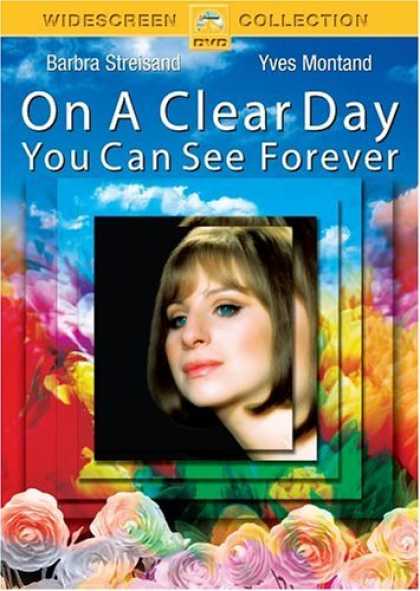On a clear day . . .
So sings Barbra Streisand in the first scene of On a Clear Day You Can See Forever, her third big-budget musical in a row and one of the most maddening films she's ever done. On Broadway, the part(s) had been played by Barbara Harris. "Part(s)" because the lead character is Daisy Gamble who, under regression hypnosis, shares of her previous life as Melinda Tentrees.

Barbra Streisand isn't bad in the part(s) Audrey Hepburn turned down but the play had a problem that should have kept it from ever being filmed, certainly with Barbra in the lead.
In January of 1969, Streisand, director Vincent Minnelli and assorted others began filming the musical. Yves Montand plays Dr. Marc Chabot and he's just awful in the role. He is as awful as Rex Reed called in real time, bleating his lyrics in a thick accent and without any warmth or humanity. He's also thickening around the middle and efforts to hide that only emphasize it. When he attempts to sing, you want ear plugs.
As awful as he is -- far worse than we've indicated -- he doesn't kill the picture.
The storyline does.
The doctor accidentally hypnotizes Daisy who shows up at one of his classes in order to stop smoking because her fiance's on her case about it. Due to that accident, Daisy ends up getting a one-on-one with the doctor followed by another and another . . . The doctor notes Daisy has unique gifts -- knowing a phone's about to ring, knowing where something is when a person is looking for it, etc. He asks her about that 'trick' and she reveals she's always been able to do it and travels back to an earlier time, the 18th century, when she was Melinda Tentrees in England.
1969 was the year Barbra would win the Academy Award for Best Actress (Funny Girl) and, having already conquered Broadway, recording and TV, this was yet another huge accomplishment for the actress. Barbra mania was high.
And no one involved in On a Clear Day You Can See Forever, seems to have grasped that.
As Daisy Gamble, Barbra used the delivery and voice America associated with her. As Melinda, she used a British accent and a more polished manner.
Montand's character falls in love with . . . Melinda.
He loathes Daisy Gamble.
He hates her. He feels she's beneath him and that she prevents him from the beauty of Melinda.
So what's happening is, audiences paying to see Barbra (no one paid to see Yves) were seeing a story onscreen that required them to root for Barbra or root for love.
Barbra or love.
"Barbra" because, again, Daisy is the public's conception of Streisand at that time. The character is how they see the actress.
And they paid to see her so it's only natural that they would root for her.
But Yves Montand's character doesn't like the character of Daisy (to the audience: Barbra) so rooting for "love" and a "happy ending" means the audience has to reject Streisand.
They weren't prepared to and that's why the film (which did make back it's cost and turn a profit when TV was taken into account) fared so poorly at the box office.
And it's why those who enjoy it today generally watch with the premise that Montand is playing a pompous blowhard.
It's easy to see why Barbra would be attracted to the part. Among other things, it allowed her to play two very distinct characters. But what does it say about the studio (Paramount) and the way they really saw Streisand?
This is not My Fair Lady. Daisy does not (and could not) become Melinda. So to feel the 'sting' the studio wanted you to, you had to regret that, you had to mourn that fact. But who wants Melinda when you've got Daisy?
Besides Paramount.
On a Clear Day You Can See Forever should be seen as one of the most curious products, a film that, to succeed, needs for you to want to dispense with the performer you paid to see.
1970. With Bob Newhart and Jack Nicholson. DVD release is in letterbox format. No special features on DVD.
